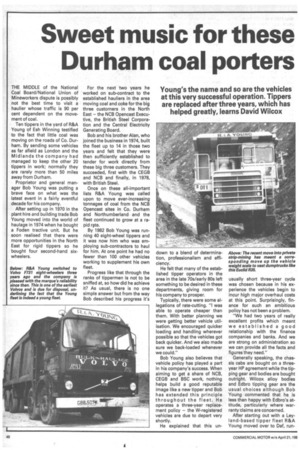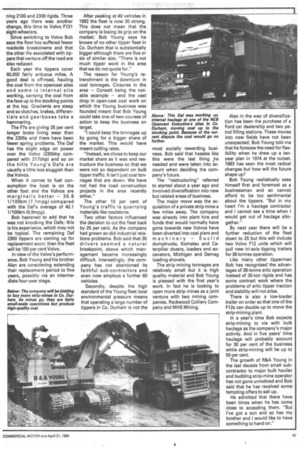Sweet music for these Durham coal porters
Page 48

Page 49

If you've noticed an error in this article please click here to report it so we can fix it.
Young's the name and so are the vehicles at this very successful operation. Tippers are replaced after three years, which has helped greatly, learns David Wilcox
THE MIDDLE of the National Coal Board/National Union of Mineworkers dispute is possibly not the best time to visit a haulier whose traffic is 90 per cent dependent on the movement of coal.
Ten tippers in the yard of R&A Young of Esh Winning testified to the fact that little coal was moving on the roads of Co. Durham. By sending some vehicles as far afield as London and the Midlands the company had managed to keep the other 20 tippers in work; normally they are rarely more than 50 miles away from Durham.
Proprietor and general manager Bob Young was putting a brave face on what was the latest event in a fairly eventful decade for his company.
After setting up in 1970 in the plant hire and building trade Bob Young moved into the world of haulage in 1974 when he bought a Feden tractive unit. But he soon realised that there were more opportunities in the North East for rigid tippers so he
bought four second-hand sixwheelers.
For the next two years he worked on sub-contract to the established hauliers in the area moving coal and coke for the big three customers in the North East — the NCB Opencast Executive, the British Steel Corporation and the Central Electricity Generating Board.
Bob and his brother Alan, who joined the business in 1974, built the fleet up to 14 in those two years and felt that they were then sufficiently established to tender for work directly from these big three customers. They succeeded, first with the CEGB and NCB and finally, in 1978, with British Steel.
Once on these all-important lists R&A Young was called upon to move ever-increasing tonnages of coal from the NCB Opencast sites in Co. Durham and Northumberland and the fleet continued to grow at a rapid rate.
By 1982 Bob Young was running 40 eight-wheel tippers and it was now him who was employing sub-contractors to haul for him. At one point he had no fewer than 100 other vehicles working to supplement his own fleet.
Progress like that through the ranks of tippermen is not to be sniffed at, so how did he achieve it? As usual, there is no one simple answer but from the way Bob described his progress it's down to a blend of determination, professionalism and efficiency.
He felt that many of the established tipper operators in the area in the late 70s/early 80s left something to be desired in these departments, giving room for his company to prosper.
Typically, there were some allegations of rate-cutting. "I was able to operate cheaper than them. With better planning we were getting better vehicle utilisation. We encouraged quicker loading and handling wherever possible so that the vehicles got back quicker. And we also made sure we back-loaded whenever we could."
Bob Young also believes that vehicle policy has played a part in his company's success. When aiming to get a share of NCB, CEGB and BSC work, nothing helps build a good reputable image like a new tipper and Bob has extended this principle throughout the fleet. He operates a three-year replacement policy — the W-registered vehicles are due to depart very shortly.
He explained that this un usually short three-year cycle was chosen because in his experience the vehicles begin to incur high major overhaul costs at this point. Surprisingly, finance for such an ambitious policy has not been a problem. "We had two years of really excellent profits which meant we established a good relationship with the finance companies and banks. And we are strong on administration so we can provide all the facts and figures they need."
Generally speaking, the chassis cabs are bought on a threeyear HP agreement while the tipping gear and bodies are bought outright. Wilcox alloy bodies and Edbro tipping gear are the usual choices although Bob Young commented that he is less than happy with Edbro's attitude, particularly where war ranty claims are concerned. After starting out with a Ley land-based tipper fleet R&A Young moved over to Daf, run ning 2100 and 2300 rigids. Three years ago there was another change, this time to Volvo F731 eight-wheelers.
Since switching to Volvo Bob says the fleet has suffered fewer roadside breakdowns and that the other ills associated with tippers that venture off the road are also reduced.
Each year the tippers cover 60,000 fairly arduous miles. A good deal is off-road, hauling the coal from the opencast sites and some is internal site working, carrying the coal from the face up to the stocking points at the top. Gradients are steep and so clutches, brakes, differentials and gearboxes take a hammering.
The F7s are giving 25 per cent longer brake lining wear than the 2305s and there have been fewer spring problems. The Oaf has the slight edge on power over the Volvo (230bhp compared with 217bhp) and so on the hills Young's Dafs are usually a little less sluggish than the Volvos.
When it comes to fuel consumption the boot is on the other foot and the Volvos are marginally better — 39.8 1/100km (7.1mpg) compared with the Des average of 40.1 1/100km (6.9mpg).
Bob hastened to add that he was not knocking the Oafs; this is his experience, which may not be typical. The remaining Daf 2300 tippers are coming up for replacement soon; then the fleet will be 100 per cent Volvo.
In view of the Volvo's performance, Bob Young and his brother Alan are considering extending their replacement period to five years, possibly via an intermediate four-year stage.
After peaking at 40 vehicles in 1982 the fleet is now 30 strong. This does not mean that the company is losing its grip on the market; Bob Young says he knows of no other tipper fleet in Co. Durham that is substantially bigger although there are five or six of similar size. "There is not much tipper work in the area that we do not quote for."
The reason for Young's retrenchment is the downturn in coal tonnages. Closures in the area — Conseil being the notable example — and the vast drop in open-cast coal work on which the Young business was founded meant that Bob Young could take one of two courses of action to keep the business on target.
"I could keep the tonnages up by going for a bigger share of the market. This would have meant cutting rates.
"Instead, we chose to keep our market share as it was and res tructure the business so that we were not so dependent on bulk tipper traffic. It isn't just coal ton nages that are down. We have not had the road construction projects in the area recently either."
The other 10 per cent of Young's traffic is quarrying materials like roadstone.
Two other factors influenced the decision to cut the fleet back by 25 per cent. As the company had grown so did industrial relations problems. Bob said that 30 drivers seemed a natural breakpoint, above which management became increasingly difficult. Interestingly, the company has not abandoned its faithful sub-contractors and even now employs a further 60 vehicles.
Secondly, despite the high standard of the Young fleet local environmental pressure means that operating a large number of tippers in Co. Durham is not the most socially rewarding business. Bob said that hassles like this were the last thing he needed and were taken into account when deciding the company's future.
The "restructuring" referred to started about a year ago and involved diversification into new but related areas of business.
The major move was the acquisition of a private strip mine a few miles away. The company was already into plant hire and funds that would normally have gone towards new Volvos have been diverted into coal plant and machinery — Euclid dumptrucks, Komatsu and Caterpillar dozers, loaders and excavators, Michigan and Demag loading shovels.
The strip mining tonnages are relatively small but it is high quality material and Bob Young is pleased with the first year's work. In fact he is looking to open more strip mines as a joint venture with two mining companies, Rackwood Colliery Company and MHS Mining. Also in the way of diversification has been the purchase of a Ford car dealership and two petrol filling stations. These moves into new fields have not been unexpected; Bob Young told me that he foresaw the need for flexibility when he drew up a tenyear plan in 1974 at the outset. 1983 has seen the most radical changes but how will the future shape up?
Bob Young realistically sees himself first and foremost as a businessman and so cannot afford to be too sentimental about the tippers. "But in my heart I'm a haulage contractor and I cannot see a time when I would get out of haulage altogether."
By next year there will be a further reduction of the fleet down to 25 but this will include two Volvo F12 units which will pull new tri-axle tipping trailers for 38 tonnes operation.
Like many other tipperman Bob has recognised the advantages of 38-tonne artic operation instead of 30-ton rigids and has some contract work where the problems of artic tipper traction and stability will not arise.
There is also a low-loader trailer on order so that one of the F12s can double up to move the strip-mining plant.
In a year's time Bob expects strip-mining to vie with bulk haulage as the company's major activity. And in five years' time haulage will probably account for 30 per cent of the business while strip-mining will be up to 50 per cent.
The growth of R8tA Young in
the last decade from small subcontractor to major bulk haulier
and budding strip-mine operator has not gone unnoticed and Bob said that he has received some tempting offers to sell up.
He admitted that there have been times when he has come close to accepting them. "But I've got a son and so has my brother and I would like to have something to hand on."




















































































